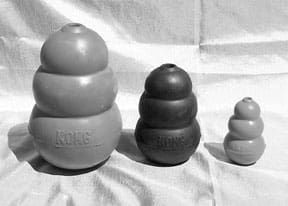I still have the very first Kong I bought 20 years ago for my Australian Kelpie, Keli. The indestructible black toy looks like it could have been purchased yesterday, despite 14 years of intensely hard use by typically obsessive herding dogs. Pre-dating the popular sport of Kong-stuffing by more than a decade, Keli was dedicated to chasing the four-inch, hollow, beehive-shaped rubber object as it bounced and boomeranged erratically across the asphalt at the shelter where we worked. Dang, it was almost as much fun as herding sheep!
Twenty years ago the Kong – originally available in just one size and color – was a novelty. Today it is made in numerous sizes, shapes, colors, and chewing densities, and is a “must-have” staple in the tool kit of most dog trainers and many wise dog owners. Dog care professionals have invented an almost endless list of uses for the innocuous-looking rubber object.
This amazing dog toy can distract a dog suffering from separation anxiety, entertain a bored dog who otherwise gets into trouble, train an under-motivated dog, etc. etc. You wouldn’t think that a mere toy could go so far as to help us cope with canines who might otherwise be labeled difficult dogs, or worse, end up on the discard pile at the local animal shelter, but Kong can do.
Top 10 uses for a Kong:
The Thrill of the Chase
This was the original application of the Kong. Because of its unique shape, the Kong bounces every which way but straight, providing intriguing quarry for the prey-oriented pooch. I doubt I would have survived the Kelpie-owning experience without engaging Keli in several intensive Kong-chasing sessions every day. Watching your dog bound and rebound after the elusive rubber prey is guaranteed to entertain you for hours on end as well as your dog.
Caveat: Herding breeds, especially, are known for literally running themselves into exhaustion. If you have a Kong-crazed dog, be careful not to induce heat-stroke or physical collapse (as I inadvertently did with Keli on two occasions) with too much Kong fun!
Puppy Distracters
Many of the more recent Kong applications involve Kong-stuffing (see “Stuff It!”, next page). Puppy distracting is one. Play-biting and inappropriate chewing are common complaints of new puppy owners. An ideal solution to perfectly normal but undesirable puppy mouth explorations is to provide an irresistible alternative to human flesh or wooden table legs – a Kong stuffed full of tantalizing treats.
Crate Training
The crate, or kennel, is a vital dog behavior management tool, and one often slighted by dog owners because of an initial poor crate training experience. (See “Crate Training Made Easy,” August 2000). When Pal is trained to the crate properly and positively, the kennel becomes his den, a haven of security and comfort. A well-stuffed Kong combined with an appropriate training program can help your dog decide that his crate is a wonderful place to be.
Cure for Cabin Fever
A few years ago, during a rain-soaked, endless El Niño California winter, our four dogs were getting seriously edgy with signs of a full-blown case of cabin fever. Stuffed Kongs to the rescue! Silence soon settled over the troubled household as our snarling canine siblings settled into their separate corners, gnawing contentedly on their respective rubber pacifiers.
Stress Reduction
Stress is the underlying cause of most canine aggression. For a dog who is uneasy with houseguests, a Kong stuffed with doggie delicacies can help change the response to visitors from negative to positive. Stress is an involuntary response – the dog can’t help it. The dog’s body reacts without conscious thought in the presence of the negative stimulus, with an immediate “Visitor – BAD!!” response. We can use the stuffed Kong as part of a well-planned counter-conditioning/desensitization program to change his involuntary response from “Visitor – STRESS” to “Visitor – OH GOODIE!”
Someone’s At The Door!
Another great visitor-related Kong application, this basis for this one is suggested by positive trainer Donna Duford. Dogs who want to greet guests too enthusiastically at the front door can be taught to fetch a toy instead. The knock at the door or the ringing of the doorbell becomes the cue to fetch the Kong, stuffed (if you know company is coming) or empty. Pal may then either retire to his rug to chew his treasure as your visitors enter, unmolested, or greet your guests politely at the door with his mouth filled with Kong instead of company. Caveat: If your dog is a food or object guarder, this may not be a good Kong application for him.
Destructo-Dog
Destructive behavior can range from simple high-spirited puppy fun to full-blown separation anxiety. By providing ample exercise for your dog, you can deplete the excess energy sometimes that leads to ruinous house-romps. An intelligently Pal-proofed environment (crate, puppy pen, safe room) can minimize the destruction that occurs during your absences. And one or more stuffed Kongs often keeps dogs happily occupied and their home damage-free while their owners are away.
Note: Crating is generally not recommended for dogs with true separation anxiety (SA) behavior disorders. While Kongs can be a useful element of a complete SA behavior modification program, this complex and troubling behavior should be addressed with an in-depth, punishment-free behavior modification program, usually under the guidance of a competent dog trainer or behavior specialist.
Hide-and-Seek
This game is an extension of the destructive behavior application of the Kong. You can occupy Pal’s mind as well as his mouth by teaching him to look for and find his stuffed Kongs before he can chew on them. Start by hiding the Kong in plain sight and asking him to “Find it!” Praise him when he does, and let him chew on it for a while. Then play the game again, hiding the toy partially behind a chair or table leg. Gradually make the hiding places harder and harder, until Pal learns to really search for his prize. Now you can hide two or three Kongs before you leave, tell him “Find It” as you walk out the door, and your dog can keep himself occupied for hours, finding and emptying his Kongs.
NOTE: Hide your Kongs wisely. If you bury them in the sofa cushions or under the bedcovers you can expect to come home to an unmade bed, and strewn cushions…or worse.
In The Swim Of Things
Here’s another good exercise application that combines Kong fun with a favorite canine activity – swimming! While most Kongs sink, the company makes one model that has a polypropylene rope tied to it, and contains a chunk of bouyant spongey material inside, so it floats like a dream. The floating rope makes the “Cool Kong,” as it is called, easy for owners to throw (swing it around and fling!) and easy for dogs who have trouble getting a whole Kong in their mouths to retrieve. It’s a durable, ideal fetch toy for the dog who already loves to swim, and the perfect training tool for the Kong-loving dog who is a bit hesitant about getting his feet wet. (See “In The Swim,” August 2000, for non-force methods of teaching your dog to enjoy the water.)
Boredom Barking
In my backyard, at this very moment, is Princess, a little stray Beagle-mix that my husband I found on the highway. She is clearly an accomplished escape artist, as evidenced by her constant running of the fenceline and her determined efforts to squeeze through our fence. Thwarted in her efforts to escape, she has taken to non-stop barking to express her displeasure at being effectively confined while we try to contact her owner. Time to bring out the stuffed Kong! Princess is now happily licking cream cheese out of the Kong, and peace has returned to the neighborhood.
There’s no doubt in our minds that this versatile toy deserves to be called “King” Kong. You can find them in almost every pet supply store and catalog – not to mention anywhere dogs are happy! In fact, we’re betting that some of you have come up with some other very creative uses for Kongs yourselves. We’d love to hear them!
Pat Miller is a freelance author and a professional dog trainer in Chattanooga, Tennessee.







What can I stuff a Kong with for a Maltese puppy?